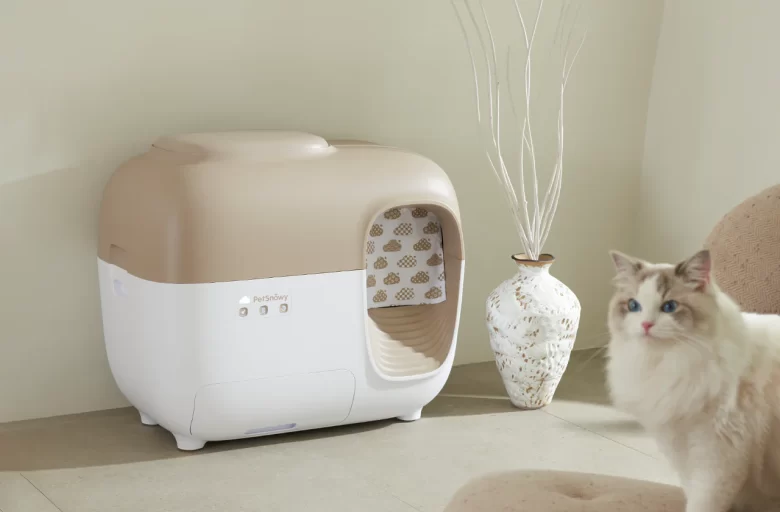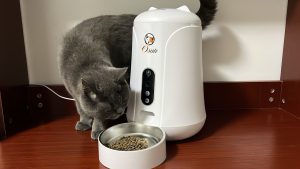When people and their cats are looking for a suitable place to live together, cleaning often comes first. The advent of automatic litter boxes has greatly reduced this concern, making the once difficult task of cleaning up litter a piece of cake. This article discusses how automatic litter boxes are changing the way people think about cleaning by making cat waste management simple, fast, and odor-free.
1. The Basics of Automatic Litter Boxes:
Automatic litter boxes, also called self-cleaning litter boxes, are a cool new gadget that sorts and automatically removes your cat’s feces from the litter box. These boxes are often equipped with sensors that can tell when a cat has used them. When this happens, a cleaning cycle begins, separating waste from clean waste and placing it in a closed section.
2. Benefits of Automatic Litter Boxes:
- Better Cleanliness and Odor Control: Automatic litter boxes remove waste quickly, reduce odor, and keep the litter box clean, which is better for both cats and their owners.
- Convenience: Because the cleaning process is now automated, pet owners don’t have to scoop as often, saving them time and energy.
- Better Hygiene: Self-cleaning stops the spread of bacteria and parasites that grow in used cat litter, making the environment healthier for pets and their owners.
- Monitor Health: More modern models can track the frequency of use and rate of weight change, which can tell you a lot about your cat’s health.
3. Features to Consider When Choosing an Automatic Litter Box:
- Size and Space: Consider how big your cat is and how much space you have in your home. Larger cats or households with more than one cat may require a larger model.
- Type of Waste: Some automatic waste containers are designed to handle certain types of waste, such as crystal waste, lump waste, or plant waste. Make sure the type of cat litter you want to use is suitable for your pet.
- Cleaning Mechanism: Different models use different cleaning methods, such as sieving, rotating, or raking. Choose one that meets your noise level and efficiency needs.
- Maintenance and Waste Disposal: See how easy it is to clean the machine and how easy it is to remove waste. Some types come with disposable containers, while others use containers that can be used multiple times.
- Cost: Automatic litter boxes vary in price depending on their brand and features. Take into account the original costs and any ongoing costs, such as the purchase of new pallets or special waste.
4. Maintain Your Automatic Litter Box:
To get the most out of your automatic litter box and ensure it lasts as long as possible, you should also perform regular maintenance in addition to automatic cleaning. This means regularly cleaning the appliance according to the manufacturer’s instructions, identifying and removing any clumps of waste that may have passed through the cleaning mechanism, and replacing or emptying the waste bin as necessary.
5. Problems that May Arise:
There are many benefits to automatic litter boxes, but there are also some things that can go wrong. Some cats are hesitant or afraid to use them at first because they make noise or move around. Mechanical problems can also occur, meaning they require repairs or troubleshooting. It’s best to slowly introduce your cat to a new litter box and check it regularly to make sure it’s working properly.
Conclusion:
Automatic litter boxes are a major advancement in pet care technology. They make one of the most annoying aspects of cat ownership much easier to accomplish. Automated cleaning processes not only make places cleaner and less smelly but they also make them better places to live. If you buy the type that suits your cat and your needs, an automatic litter box can be a good investment that can change the way people think about cleaning a cat house.
FAQs:
1. What is a self-cleaning litter box?
An electronic device called an automatic litter box makes removing cat litter easier. It has parts that separate the waste from the waste and place it in a sealed compartment so you don’t have to scoop it up with your hands.
2. How does a self-cleaning litter box work?
Most automatic litter boxes have sensors that can tell when your cat has gone to the toilet and used the litter box. Start the cleaning cycle after a certain time so that the cat has time to leave. The waste is then raked or sieved in different areas. While clean waste is left behind, the waste is kept in locked areas to reduce odors until it can be disposed of.
3. What about automatic litter boxes? Are they safe for cats?
Most self-contained litter boxes are safe for cats. They have a safety feature that stops the cleaning process if the cat returns to the box or finds an obstacle. However, it is important to choose a model with good safety measures and follow the manufacturer’s instructions.
4. What types of waste can be used in robotic bins?
Some types of waste cannot be used in automatic garbage bins. Many people need good quality clumping cat litter to work properly because it separates litter cleanly from litter. Crystal, natural, or non-clumping cat litter may not work well with each other. Before choosing a nest, you should consult the manufacturer’s instructions.
5. How often should you clean your automatic litter box?
The number of cats using the litter box, and the size and type of litter box all affect how often the litter box needs to be cleaned. In general, a cat may need to have the area cleaned once a week, but this can change.
6. Do robotic litter boxes help remove odors?
Automatic litter boxes can go a long way in controlling odors as the waste is removed immediately and stored in a locked area. But how effective it is also depends on the type of cat litter used and how often the litter box is cleaned.


